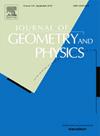非周期磁Schrödinger算子谱投影k理论中的消失定理
IF 1.2
3区 数学
Q1 MATHEMATICS
引用次数: 0
摘要
考虑有界几何黎曼流形M上的Schrödinger算子H(μ)=∇A△∇A+μV,其中μ>;0为耦合参数,磁场B=dA,电势V均为C∞有界,V≥0。我们假设,对于某个E0>;0,势V的子电平集{V<;E0}的每个连通分量是相对紧的。在某些假设几何和光谱特性的连接组件,我们表明,足够大的μ,H(μ)的光谱区间[0,E0μ]有一个缺口,H(μ)的光谱投影,对应于时间间隔(−∞,λλ的差距,属于Roe C⁎代数C⁎(M)的流形M,如果M不紧凑,它的类的K C⁎理论(M)是微不足道的。本文章由计算机程序翻译,如有差异,请以英文原文为准。
A vanishing theorem in K-theory for spectral projections of a non-periodic magnetic Schrödinger operator
We consider the Schrödinger operator on a Riemannian manifold M of bounded geometry, where is a coupling parameter, the magnetic field and the electric potential V are uniformly -bounded, . We assume that, for some , each connected component of the sublevel set of the potential V is relatively compact. Under some assumptions on geometric and spectral properties of the connected components, we show that, for sufficiently large μ, the spectrum of in the interval has a gap, the spectral projection of , corresponding to the interval with λ in the gap, belongs to the Roe -algebra of the manifold M, and, if M is not compact, its class in the K theory of is trivial.
求助全文
通过发布文献求助,成功后即可免费获取论文全文。
去求助
来源期刊

Journal of Geometry and Physics
物理-物理:数学物理
CiteScore
2.90
自引率
6.70%
发文量
205
审稿时长
64 days
期刊介绍:
The Journal of Geometry and Physics is an International Journal in Mathematical Physics. The Journal stimulates the interaction between geometry and physics by publishing primary research, feature and review articles which are of common interest to practitioners in both fields.
The Journal of Geometry and Physics now also accepts Letters, allowing for rapid dissemination of outstanding results in the field of geometry and physics. Letters should not exceed a maximum of five printed journal pages (or contain a maximum of 5000 words) and should contain novel, cutting edge results that are of broad interest to the mathematical physics community. Only Letters which are expected to make a significant addition to the literature in the field will be considered.
The Journal covers the following areas of research:
Methods of:
• Algebraic and Differential Topology
• Algebraic Geometry
• Real and Complex Differential Geometry
• Riemannian Manifolds
• Symplectic Geometry
• Global Analysis, Analysis on Manifolds
• Geometric Theory of Differential Equations
• Geometric Control Theory
• Lie Groups and Lie Algebras
• Supermanifolds and Supergroups
• Discrete Geometry
• Spinors and Twistors
Applications to:
• Strings and Superstrings
• Noncommutative Topology and Geometry
• Quantum Groups
• Geometric Methods in Statistics and Probability
• Geometry Approaches to Thermodynamics
• Classical and Quantum Dynamical Systems
• Classical and Quantum Integrable Systems
• Classical and Quantum Mechanics
• Classical and Quantum Field Theory
• General Relativity
• Quantum Information
• Quantum Gravity
 求助内容:
求助内容: 应助结果提醒方式:
应助结果提醒方式:


